Slope Stability and Effectiveness of Treatment Measures during Earthquake
Abstract
:1. Introduction
2. Description of Bainigou Slope
2.1. Overview
2.2. Engineering Geology
2.3. Deformation of Slope
3. Numerical Simulation of Slope
3.1. Numerical Modeling
- (1)
- In the stage of static analysis, the horizontal and vertical degrees of freedom (DOFs) of the bottom boundary for the model are fixed, and the horizontal and vertical DOFs of the lateral boundary for the model are fixed and free, respectively.
- (2)
- In the stage of dynamic analysis, as seismic motion is applied at the bottom of the model in the form of a stress time history, a quiet boundary is adopted at the bottom of the model, and a free field boundary is adopted at the lateral boundary of the model. Considering that Rayleigh damping can approximately reflect the frequency independence of rock and soil materials [38], the Rayleigh damping of 5% proportional mass and stiffness is selected.
- (3)
- The typical earthquake ground motion of the El Centro, California Imperial Valley earthquake of 18 May 1940 is selected, and such an earthquake was induced by a strike–slip fault. The NS component of the El Centro (1940) earthquake is used for seismic motion, as shown in Figure 7a. The duration of this motion is 53.7 s, and the maximum acceleration is 0.39 g, which occurred at 2.2 s. Before inputting seismic motion, a baseline correction needed to be carried out to convert seismic motion from acceleration to stress; meanwhile, we ensured that the final displacement of seismic motion was 0. Finally, the stress time history is imparted to the bottom of the model. Figure 7b illustrates the displacement time histories of seismic motion before and after correction.
3.2. Validation of Numerical Model
4. Computed Response before Treatment
5. Computed Response after Treatment
5.1. Treatment Measures
5.2. Response of Supporting Structures
5.3. Response of Slope
6. Summary and Conclusions
- (1)
- Under natural conditions, the displacement of the sliding body presents a cumulative phenomenon from the back edge to the front edge, and the maximum shear strain increment distributes along the sliding surface, but does not penetrate.
- (2)
- The stability of the slope is greatly influenced by the earthquake, and the three treatment measures improve effectively the stability of the slope after comparing the response of the slope before and after treatment. The slope after treatment is stable according to the displacement time histories of recorded points.
- (3)
- The shear force and bending moment on the anti-slide pile should be closely related to the intensity of the input earthquake motion, and the displacement of the anti-slide pile depends on the sliding displacement of the slope. The smaller shear force and bending moment on the anti-slide pile indicate that the excavation effectively reduces the sliding force of the slope at the end of shaking.
- (4)
- The axial force of four anchor cables presents an obvious change before shaking and at the end of shaking, which indicates that there may be a local sliding risk near the quarry slope.
- (5)
- The parameters of excavation and supporting structures in this study are all specified values, and the influence of changing the parameters on the slope stability is not considered. Therefore, the next investigation will mainly focus on improving the slope stability via parameter optimization and comparing the treatment effects of different measures.
- (6)
- In this study, only one seismic motion is selected in the dynamic analysis of the model, so the influence of different frequencies and amplitudes can be explored in the next slope stability investigation by selecting multiple seismic motions.
Author Contributions
Funding
Data Availability Statement
Conflicts of Interest
References
- Jagodnik, V.; Arbanas, Z. Cyclic behaviour of uniform sand in drained and undrained conditions at low confining stress in small-scale landslide model. Sustainability 2022, 14, 12797. [Google Scholar] [CrossRef]
- Fan, X.; Scaringi, G.; Xu, Q.; Zhan, W.; Dai, L.; Li, Y.; Pei, X.; Yang, Q.; Huang, R. Coseismic landslides triggered by the 8th August 2017 Ms 7.0 Jiuzhaigou earthquake (Sichuan, China): Factors controlling their spatial distribution and implications for the seismogenic blind fault identification. Landslides 2018, 15, 967–983. [Google Scholar] [CrossRef]
- Cui, Y.; Bao, P.; Xu, C.; Ma, S.; Zheng, J.; Fu, G. Landslides triggered by the 6 September 2018 Mw 6.6 Hokkaido, Japan: An updated inventory and retrospective hazard assessment. Earth Sci. Inform. 2021, 14, 247–258. [Google Scholar] [CrossRef]
- Shi, Z.; Xiong, X.; Peng, M.; Zhang, L.M.; Xiong, Y.F.; Chen, H.X.; Zhu, Y. Risk assessment and mitigation for the Hongshiyan landslide dam triggered by the 2014 Ludian earthquake in Yunnan, China. Landslides 2016, 14, 269–285. [Google Scholar] [CrossRef]
- Luo, J.; Pei, X.J.; Evans, S.G.; Huang, R.Q. Mechanics of the earthquake-induced Hongshiyan landslide in the 2014 Mw 6.2 Ludian earthquake, Yunnan, China. Eng. Geol. 2019, 251, 197–213. [Google Scholar] [CrossRef]
- Chigira, M.; Wu, X.Y.; Inokuchi, T.; Wang, G.H. Landslides induced by the 2008 Wenchuan earthquake, Sichuan, China. Geomorphology 2010, 118, 225–238. [Google Scholar] [CrossRef]
- Dai, F.; Tu, X.; Xu, C.; Gong, Q.; Yao, X. Rock avalanches triggered by oblique-thrusting during the 12 May 2008 Ms 8.0 Wenchuan earthquake, China. Geomorphology 2011, 132, 300–318. [Google Scholar] [CrossRef]
- Yuan, R.M.; Tang, C.L.; Hu, J.C.; Xu, X.W. Mechanism of the Donghekou landslide triggered by the 2008 Wenchuan earthquake revealed by discrete element modeling. Nat. Hazards Earth Syst. Sci. 2014, 14, 1195–1205. [Google Scholar] [CrossRef] [Green Version]
- Song, Y.; Huang, D.; Cen, D. Numerical modelling of the 2008 Wenchuan earthquake-triggered Daguangbao landslide using a velocity and displacement dependent friction law. Eng. Geol. 2016, 215, 50–68. [Google Scholar] [CrossRef]
- Ren, Z.K.; Zhang, Z.Q.; Zhang, H.P.; Zheng, W.J.; Zhang, P.Z. The role of the 2008 Mw 7.9 Wenchuan earthquake in topographic evolution: Seismically induced landslides and the associated isostatic response. Tectonics 2018, 37, 2748–2757. [Google Scholar] [CrossRef]
- Zhou, S.; Fang, L.; Liu, B. Slope unit-based distribution analysis of landslides triggered by the April 20, 2013, Ms 7.0 Lushan earthquake. Arab. J. Geosci. 2015, 8, 7855–7868. [Google Scholar] [CrossRef]
- Cheng, H.; Zhou, J.; Chen, Z.; Huang, Y.A. comparative study of the seismic performances and failure mechanisms of slopes using dynamic centrifuge modeling. J. Earth Sci. 2021, 32, 1166–1173. [Google Scholar] [CrossRef]
- Xu, R.; Zhang, S.; Li, Z.; Yan, X. Experimental investigation of the strain rate effect on crack initiation and crack damage thresholds of hard rock under quasi-static compression. Acta Geotech. 2023, 18, 903–920. [Google Scholar] [CrossRef]
- Jing, J.; Wu, Z.; Yan, W.; Ma, W.; Liang, C.; Lu, Y.; Chen, D. Experimental study on progressive deformation and failure mode of loess fill slopes under freeze-thaw cycles and earthquakes. Eng. Geol. 2022, 310, 106896. [Google Scholar] [CrossRef]
- Kim, Y.A.; Lee, H.I.; Ko, K.W.; Kwon, T.H. Centrifuge modeling and analytical validation of seismic amplification in a slope during earthquakes–implications to seismic slope stability analysis. Soil Dyn. Earthq. Eng. 2022, 163, 107502. [Google Scholar] [CrossRef]
- Tan, W.; Huang, Q.; Chen, X. Physical model test on the interface of loess fill slope. Land 2022, 11, 1372. [Google Scholar] [CrossRef]
- Yang, B.; Hou, J.; Zhou, Z.; Gou, J. Failure behavior and mechanism of a slope under the action of earthquake after rainfall. Nat. Hazards 2023. [Google Scholar] [CrossRef]
- Wang, L.Q.; Yin, Y.P.; Zhang, Z.H.; Huang, B.L.; Wei, Y.G.; Zhao, P.; Hu, M.J. Stability analysis of the Xinlu Village landslide (Chongqing, China) and the influence of rainfall. Landslides 2019, 16, 1993–2004. [Google Scholar] [CrossRef]
- Liu, X.; Wang, Y.; Li, D.Q. Numerical simulation of the 1995 rainfall-induced Fei Tsui Road landslide in Hong Kong: New insights from hydro-mechanically coupled material point method. Landslides 2020, 17, 27–277. [Google Scholar] [CrossRef]
- Xu, J.; Ueda, K.; Uzuoka, R. Numerical modeling of seepage and deformation of unsaturated slope subjected to post-earthquake rainfall. Comput. Geotech. 2022, 148, 104791. [Google Scholar] [CrossRef]
- Gao, G.; Meguid, M.A.; Chouinard, L.E.; Zhan, W.W. Dynamic disintegration processes accompanying transport of an earthquake-induced landslide. Landslides 2020, 18, 909–933. [Google Scholar] [CrossRef]
- Wang, H.L.; Liu, S.Q.; Xu, W.Y.; Yan, L.; Qu, X.; Xie, W.C. Numerical investigation on the sliding process and deposit feature of an earthquake-induced landslide: A case study. Landslides 2020, 17, 2671–2682. [Google Scholar] [CrossRef]
- Cho, Y.; Rathje, E.M. Generic predictive model of earthquake-induced slope displacements derived from finite-element analysis. J. Geotech. Geoenviron.Eng. 2022, 148, 04022010. [Google Scholar] [CrossRef]
- Ye, S.; Shi, Y. Reliability analysis of slope reinforced by anchors under earthquake action. Soil Mech. Found. Eng. 2022, 59, 376–384. [Google Scholar] [CrossRef]
- Hwang, Y.W.; Rathje, E.M. Insights into seismic slope deformation patterns using finite element analysis. Soil Dyn. Earthq. Eng. 2023, 164, 107660. [Google Scholar] [CrossRef]
- Yan, G.Q.; Yin, Y.P.; Huang, B.L.; Zhang, Z.H.; Zhu, S.N. Formation mechanism and characteristics of the Jinjiling landslide in Wushan in the Three Gorges Reservoir region, China. Landslides 2019, 16, 2087–2101. [Google Scholar] [CrossRef]
- Wang, Z.; Shi, F.; Li, D.; Li, H. Tunneling-induced deep-seated landslides: A case study in Gulin County, Sichuan, China. Arab. J. Geosci. 2020, 13, 71–78. [Google Scholar] [CrossRef]
- Yang, Z.; Fan, X.; Yang, Y.; Hou, K.; Du, J.; Chen, X.; Mi, Y.; Jiang, C.; Zhang, J.; Guo, Y. Deformation patterns and failure mechanism of high and steep stratified rock slopes with upper steep and lower gentle style induced by step-by-step excavations. Environ. Earth Sci. 2022, 81, 229. [Google Scholar] [CrossRef]
- Yin, Y.; Li, B.; Wang, W. Dynamic analysis of the stabilized Wangjiayan landslide in the Wenchuan Ms 8.0 earthquake and aftershocks. Landslides 2015, 12, 537–547. [Google Scholar] [CrossRef]
- Ding, H.; Chen, J.; Song, L. The force analysis of anchor anti-slide pile in slope reinforcement under seismic load. Appl. Mech. Mater. 2015, 777, 148–153. [Google Scholar] [CrossRef]
- Lai, J.; Zheng, Y.; Liu, Y.; Li, X.; Liu, H. Seismic design of multiple anti-slide piles by strength reduction dynamics analysis method. Electron. J. Geotech. Eng. 2015, 20, 1725–1737. [Google Scholar]
- Zhang, M.; Yin, Y.P.; Huang, B.L. Mechanisms of rainfall-induced landslides in gently inclined red beds in the eastern Sichuan Basin, SW China. Landslides 2015, 12, 973–983. [Google Scholar] [CrossRef]
- Cheng, D.; Cui, Y.; Su, F.; Jia, Y.; Choi, C.E. The characteristics of the Mocoa compound disaster event, Colombia. Landslides 2018, 15, 1223–1232. [Google Scholar] [CrossRef] [Green Version]
- Lin, F.; Wu, L.Z.; Huang, R.Q.; Zhang, H. Formation and characteristics of the Xiaoba landslide in Fuquan, Guizhou, China. Landslides 2018, 15, 669–681. [Google Scholar] [CrossRef]
- Huang, Y.; Xu, X.; Mao, W. Numerical performance assessment of slope reinforcement using a pile-anchor structure under seismic loading. Soil Dyn. Earthq. Eng. 2020, 129, 105963. [Google Scholar] [CrossRef]
- Qiao, S.; Xu, P.; Teng, J.; Sun, X. Numerical study of optimal parameters on the high filling embankment landslide reinforced by the portal anti-slide pile. KSCE J. Civ. Eng. 2020, 24, 1460–1475. [Google Scholar] [CrossRef]
- Yang, X.; Diao, X.; Zhou, T.; Hu, F.; Wang, S. Study on the stability of accumulated layer landslide under the coupling action of earthquake and rainfall. KSCE J. Civ. Eng. 2023, 27, 98–108. [Google Scholar] [CrossRef]
- Itasca Consulting Group, Inc. FLAC (Fast Lagrangian Analysis of Continua); User’s Manual-Version 7.0; Itasca Consulting Group, Inc.: Minneapolis, MN, USA, 2011. [Google Scholar]
- Jong, D.Y.; Han, U.C.; Jang, U.J.; Ri, Y.N. Determination of safety factor for rock mass surrounding tunnel by sudden change of equivalent plastic strain in strength reduction method. Geotech. Geol. Eng. 2022, 40, 3493–3509. [Google Scholar] [CrossRef]
- Li, Z.; Liu, J.; Liu, H.; Zhao, H.; Xu, R.; Gurkalo, F. Stress distribution in direct shear loading and its implication for engineering failure analysis. Int. J. Appl. Mech. 2023. [Google Scholar] [CrossRef]
- Zhang, Z.; Li, Z.; Xu, G.; Gao, X.; Liu, Q.; Li, Z.; Liu, J. Lateral abutment pressure distribution and evolution in wide pillars under the first mining effect. Int. J. Min. Sci. Technol. 2023. [Google Scholar] [CrossRef]
- Xu, J.; Zheng, Y.; Ye, H.; Feng, X. Research of embedded anti-slide pile supporting slope during earthquake. Chin. J. Undergr. Space Eng. 2011, 7, 781–788. (In Chinese) [Google Scholar]
- Wu, R.; Zhou, H.; Hu, Y.; Li, P.; Zhong, Y. Research on distribution law of landslide thrust of anchored anti-slide pile base on FLAC3D. J. Disaster Prev. Mitig. Eng. 2013, 33, 548–555. (In Chinese) [Google Scholar]
- Sun, J.; Yu, T.; Dong, P. Pseudo-dynamic analysis of reinforced slope with anchor cables. Soil Dyn. Earthq. Eng. 2022, 162, 107514. [Google Scholar] [CrossRef]
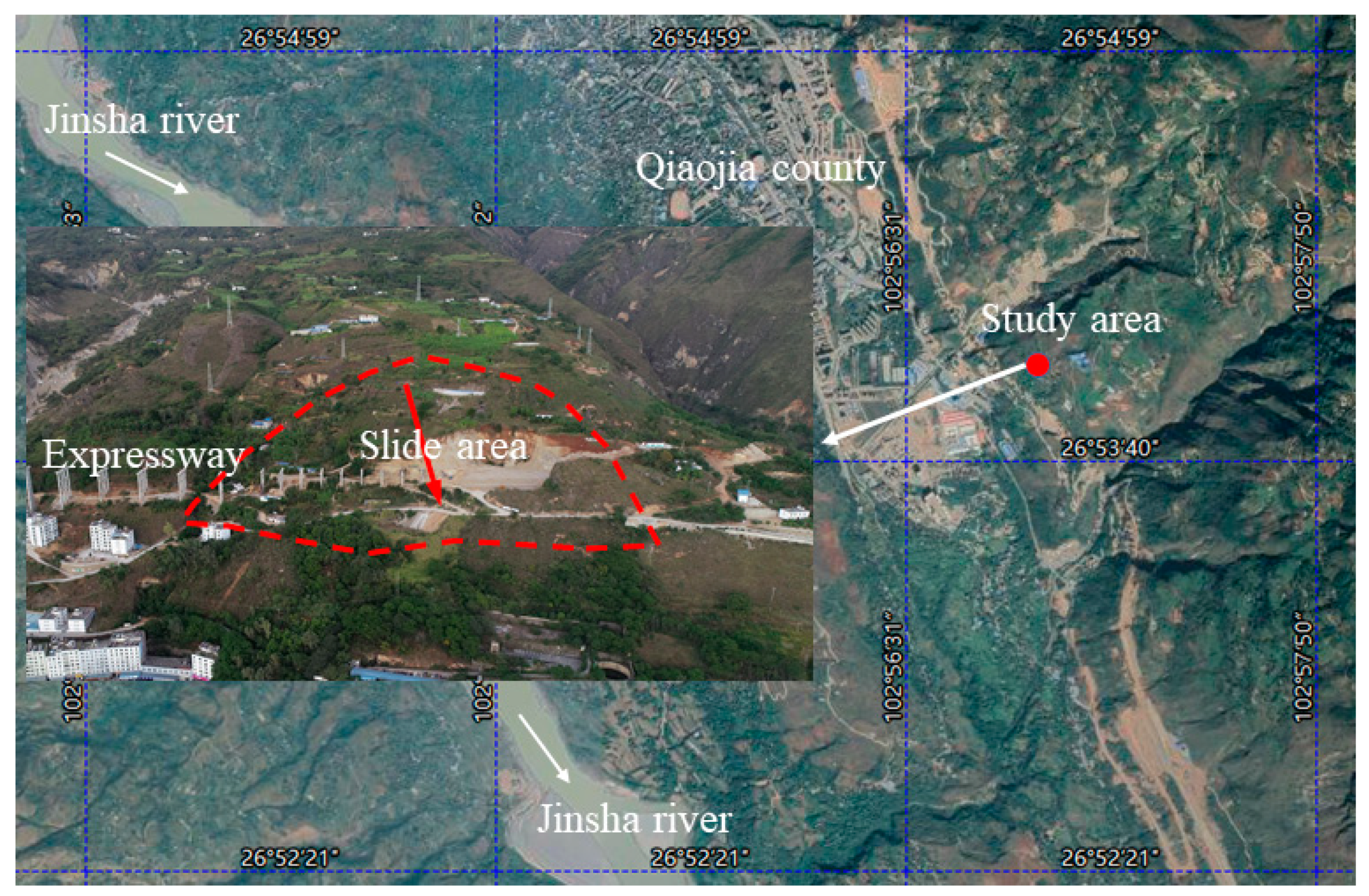
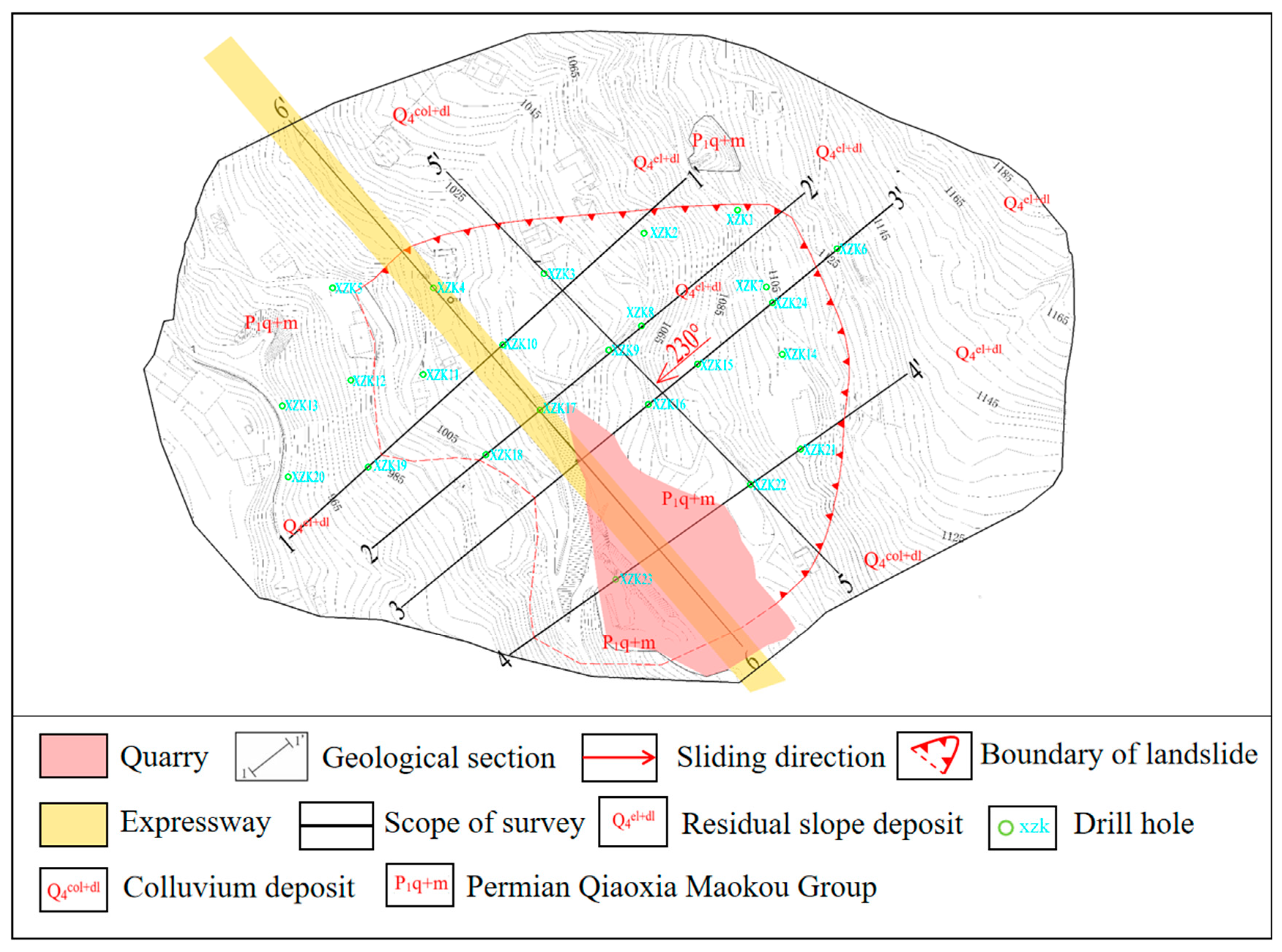
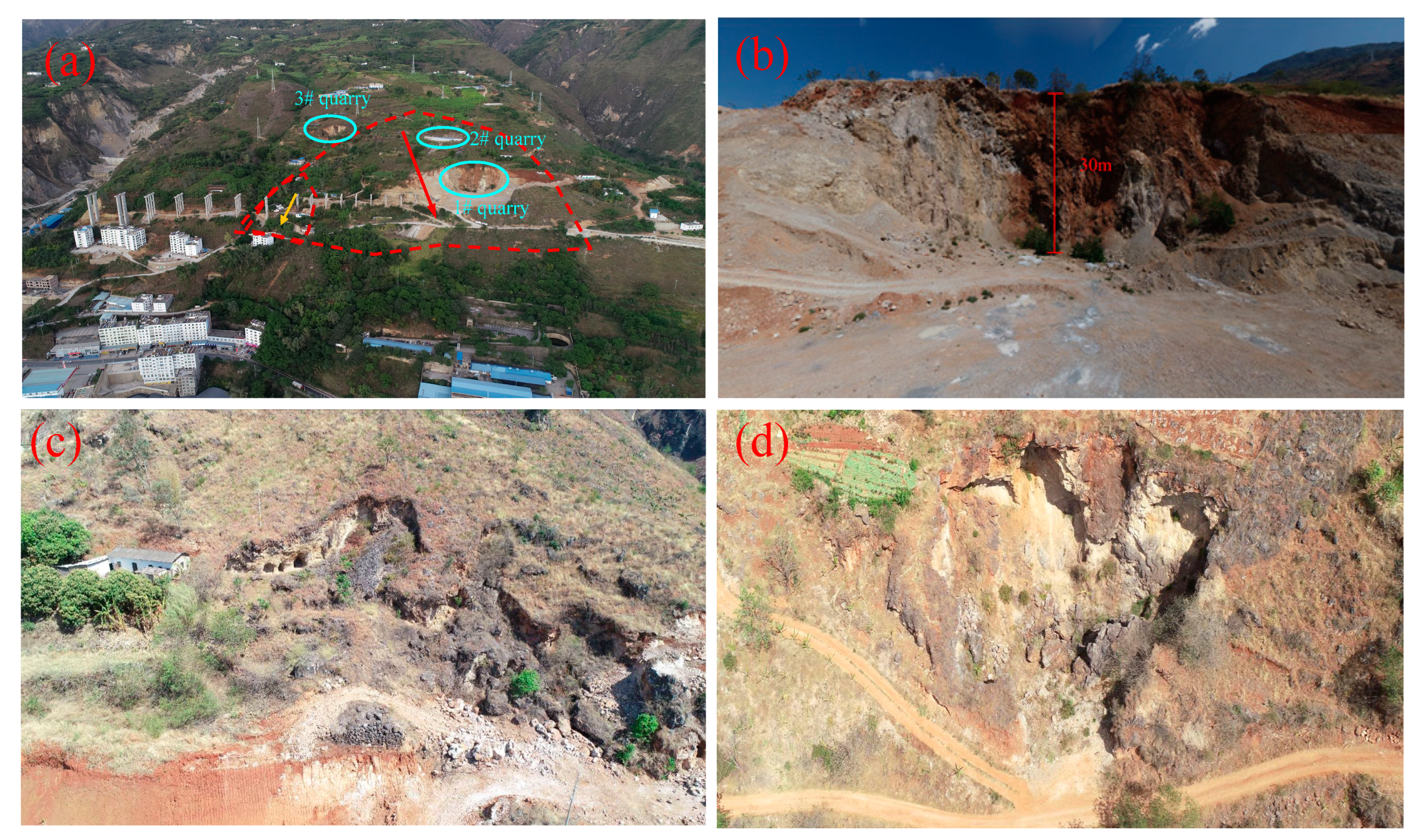
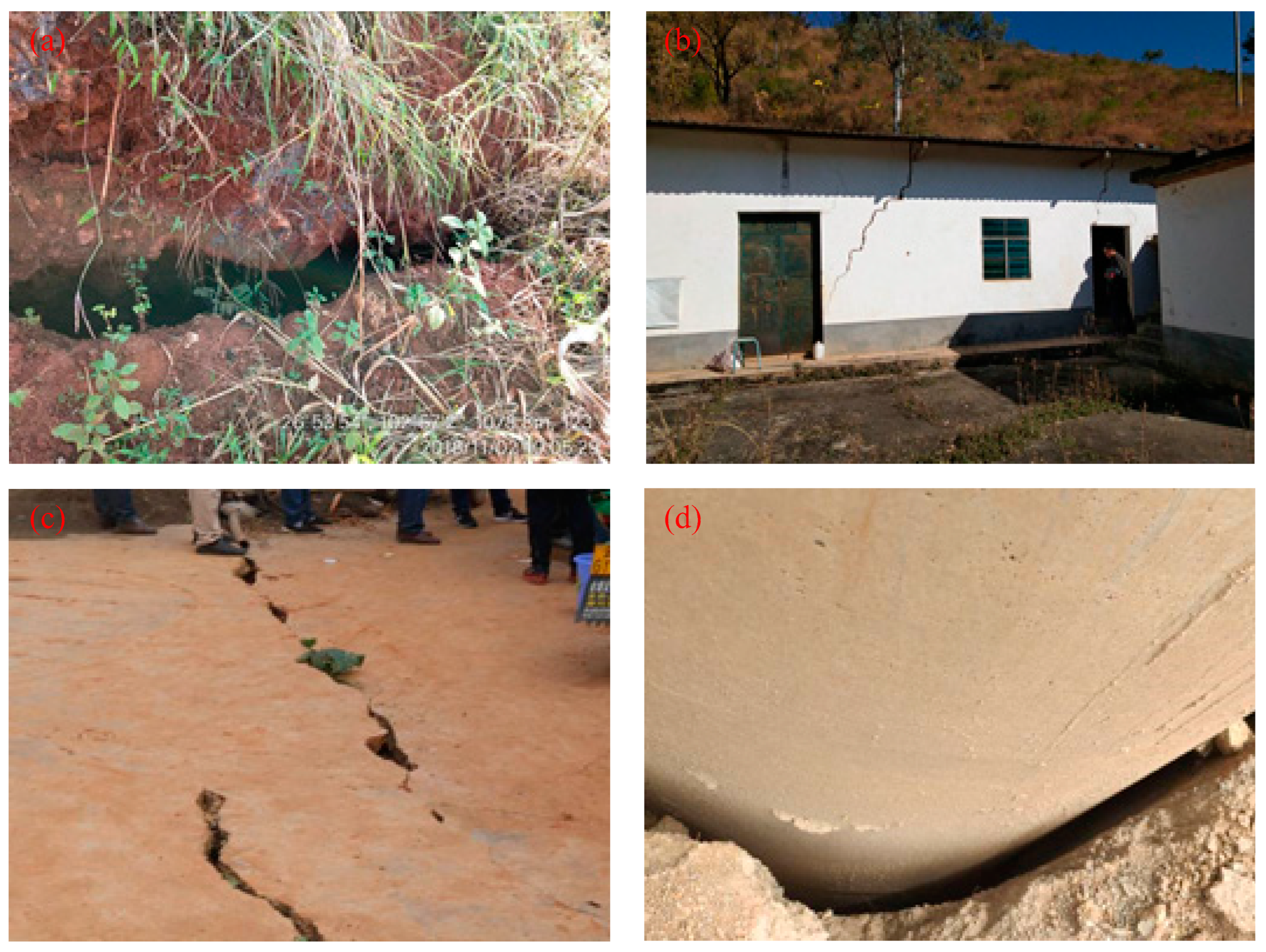
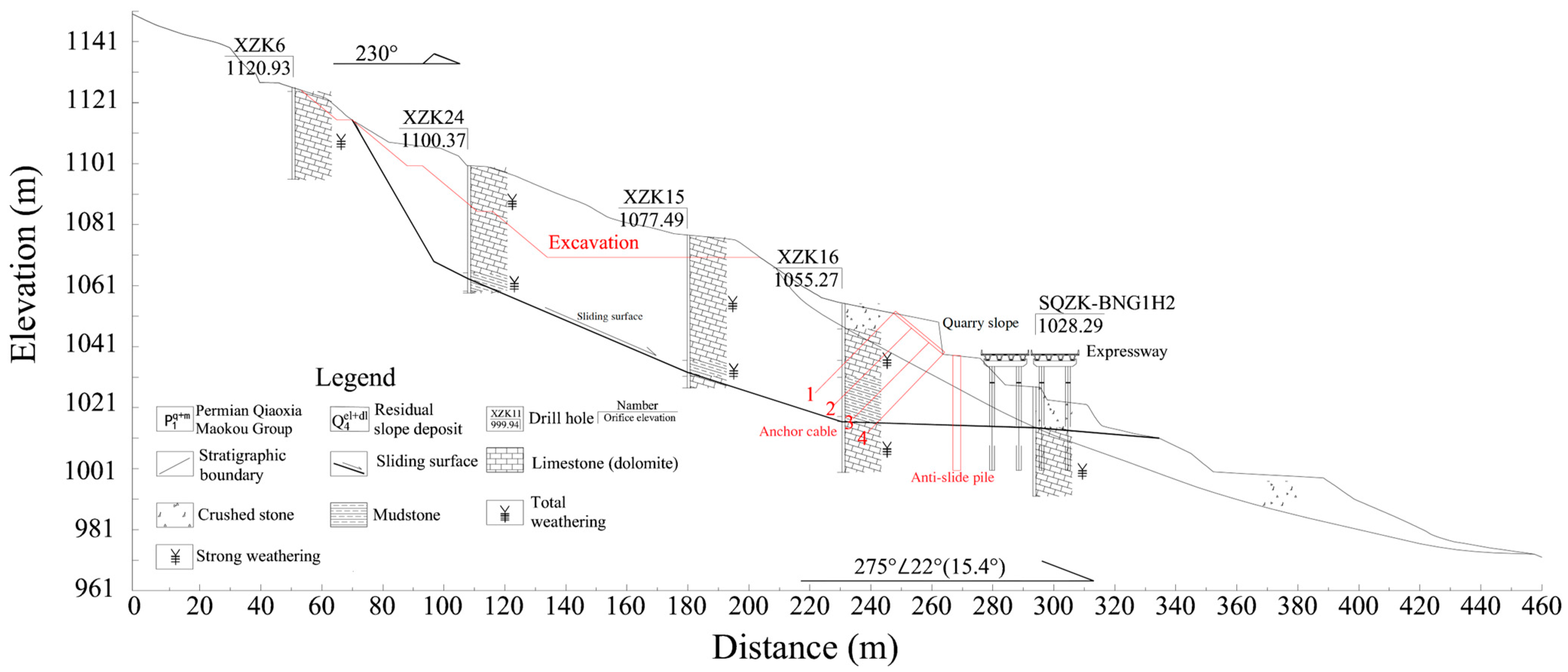
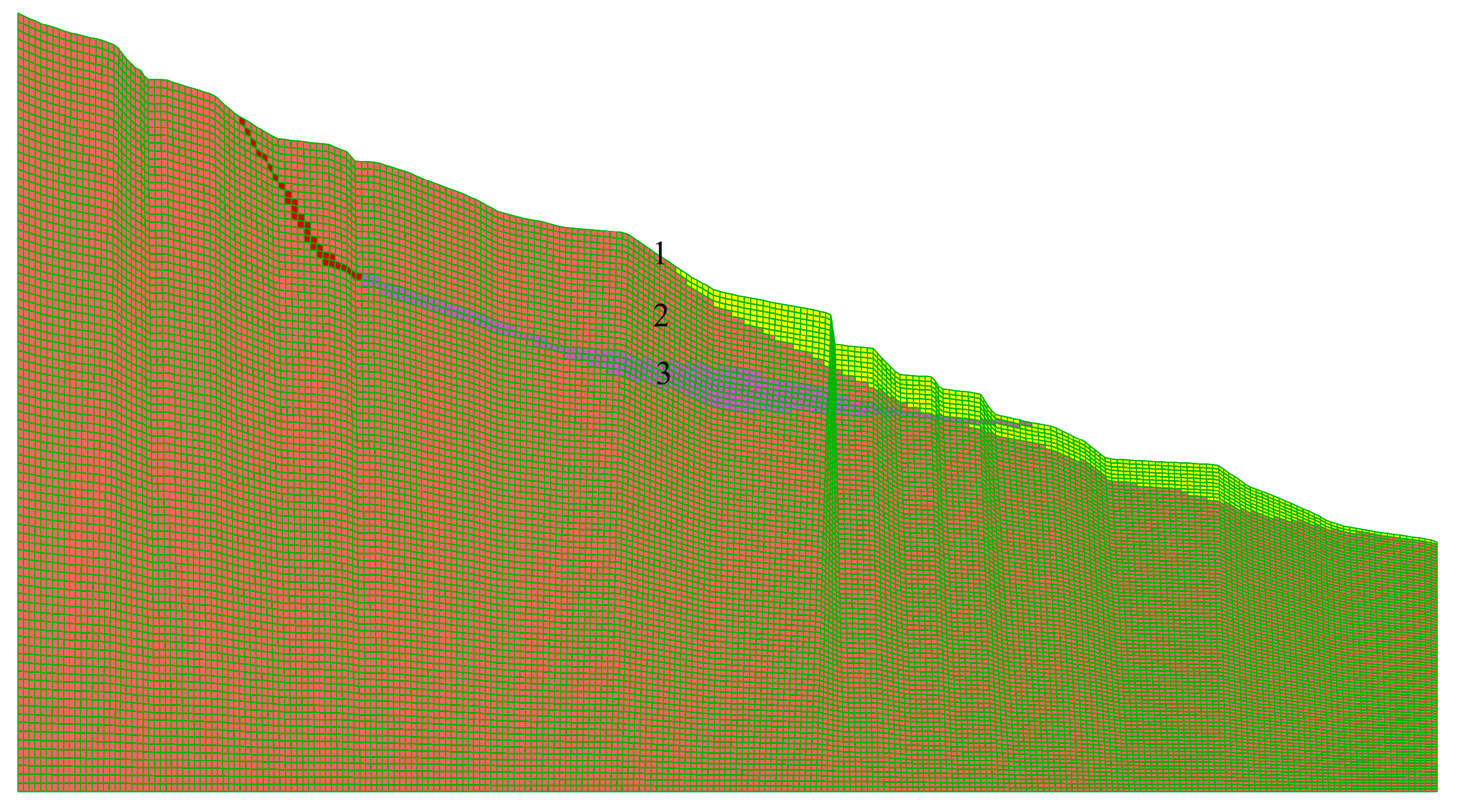
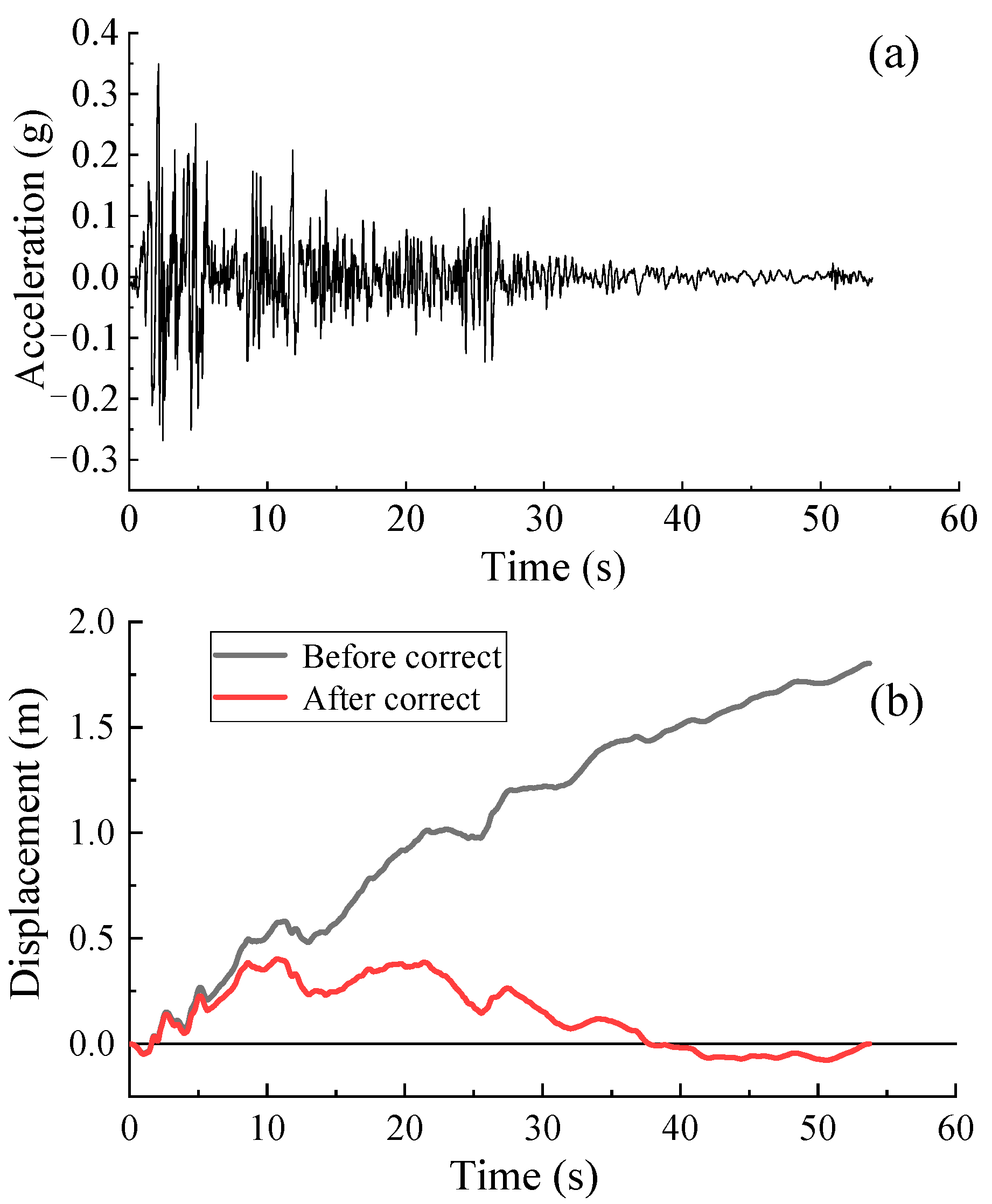
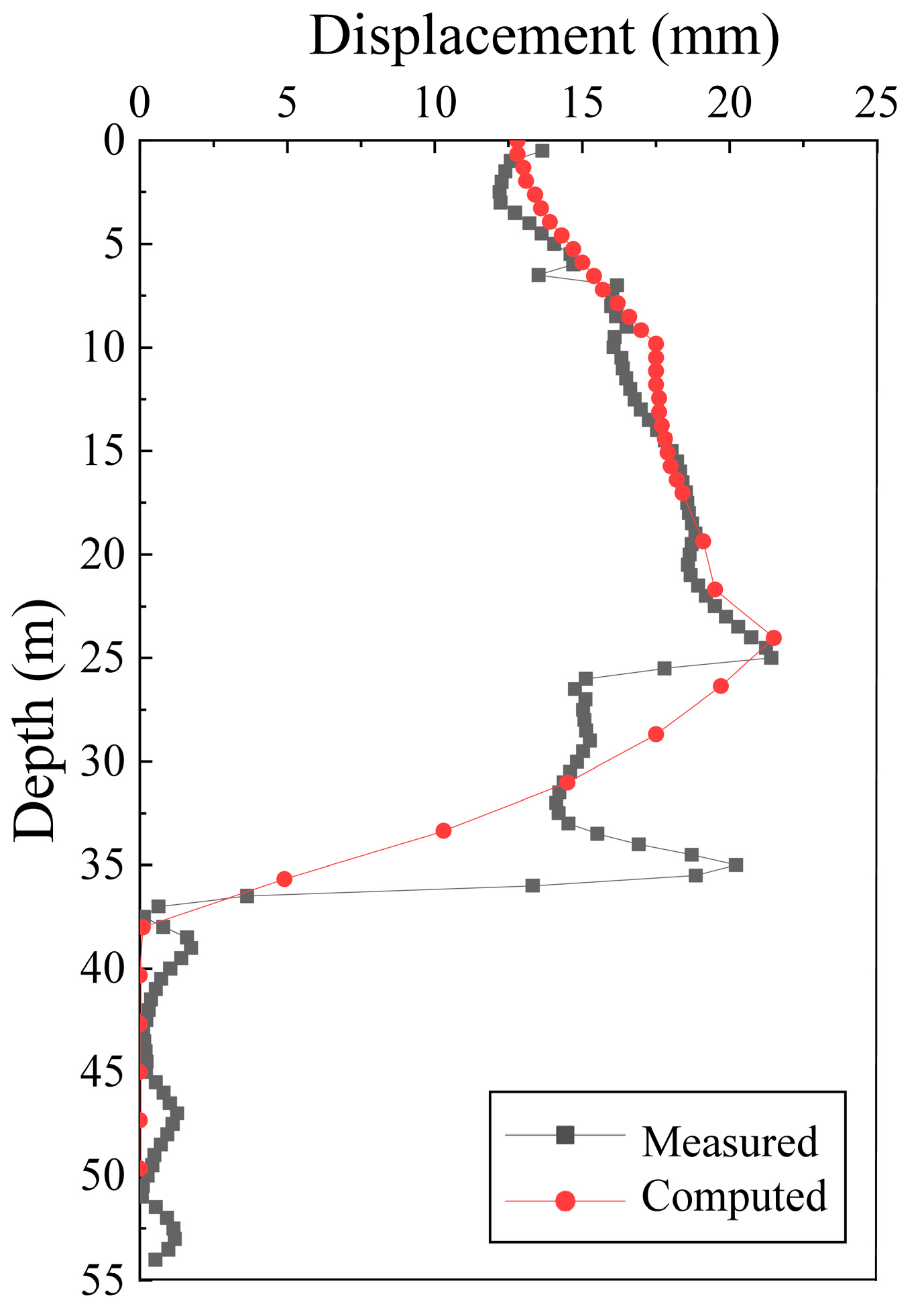

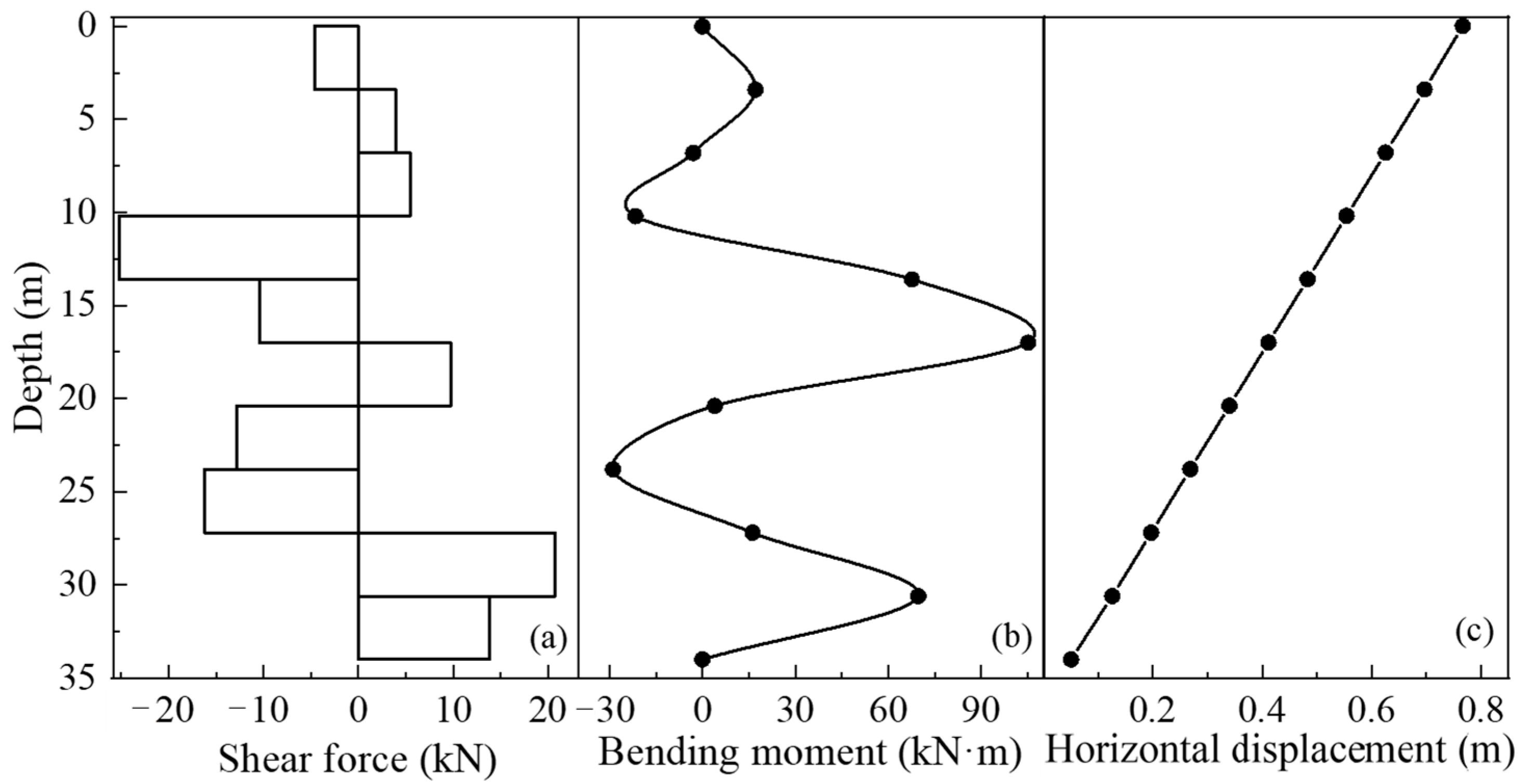
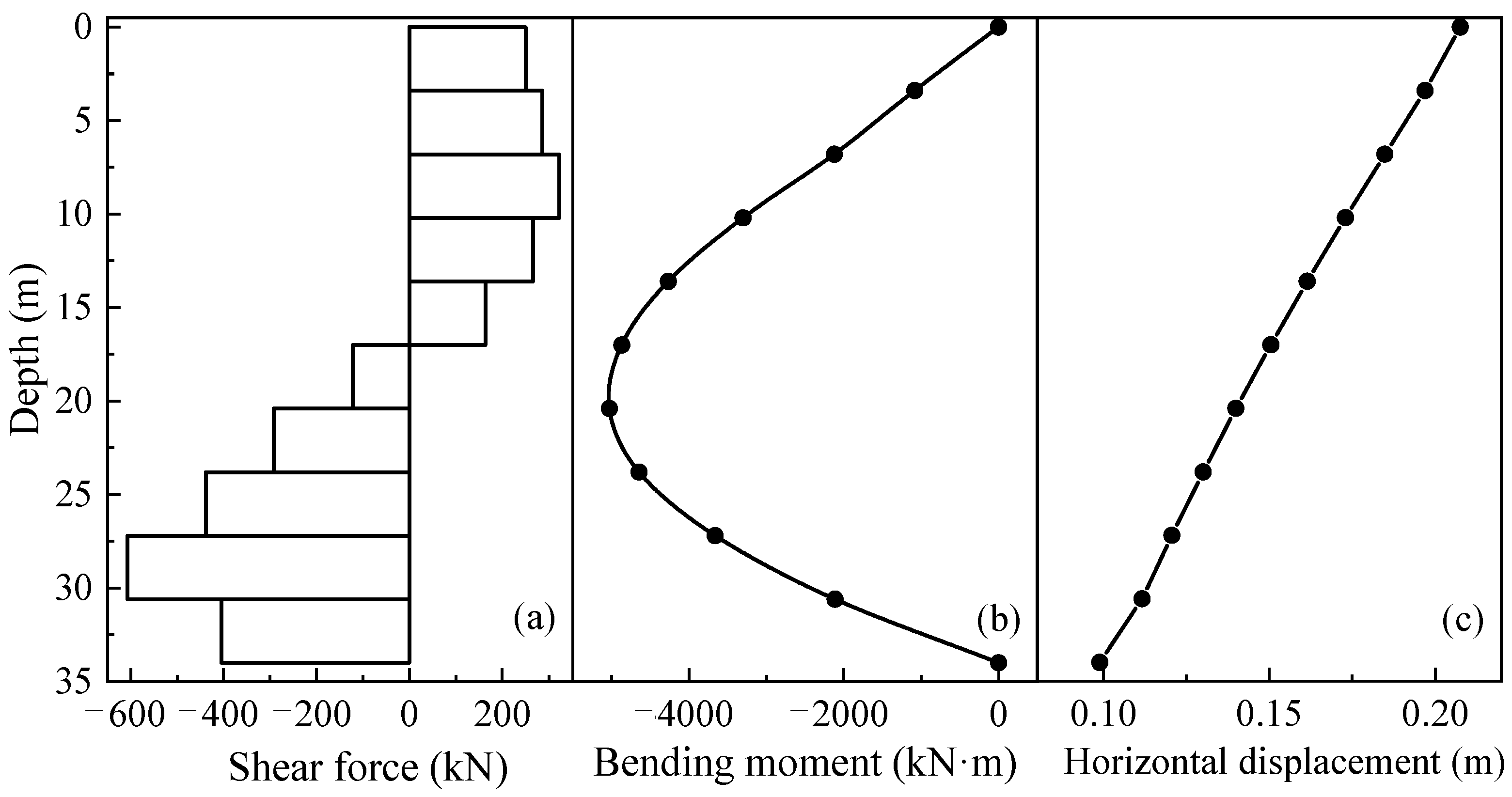
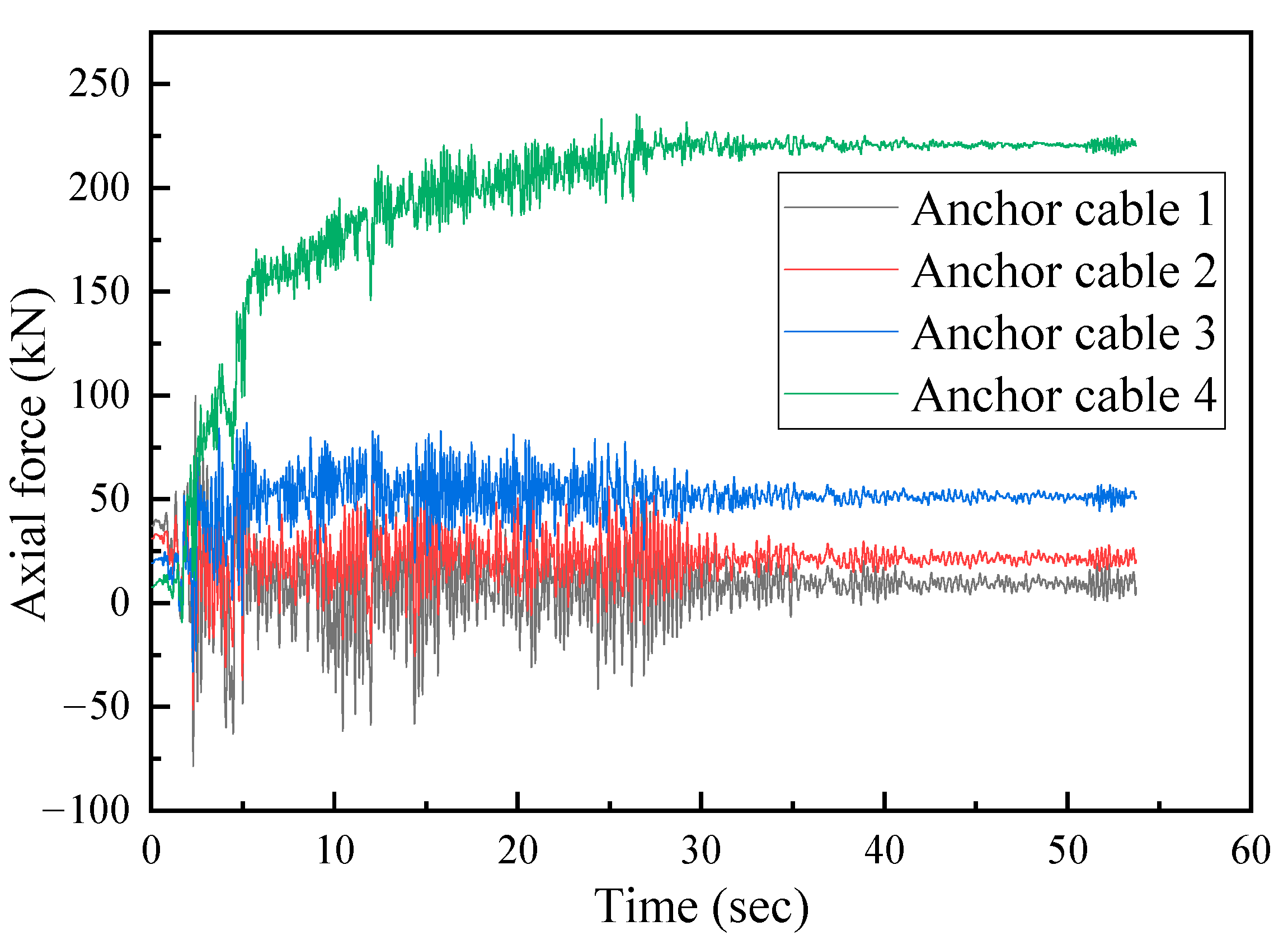

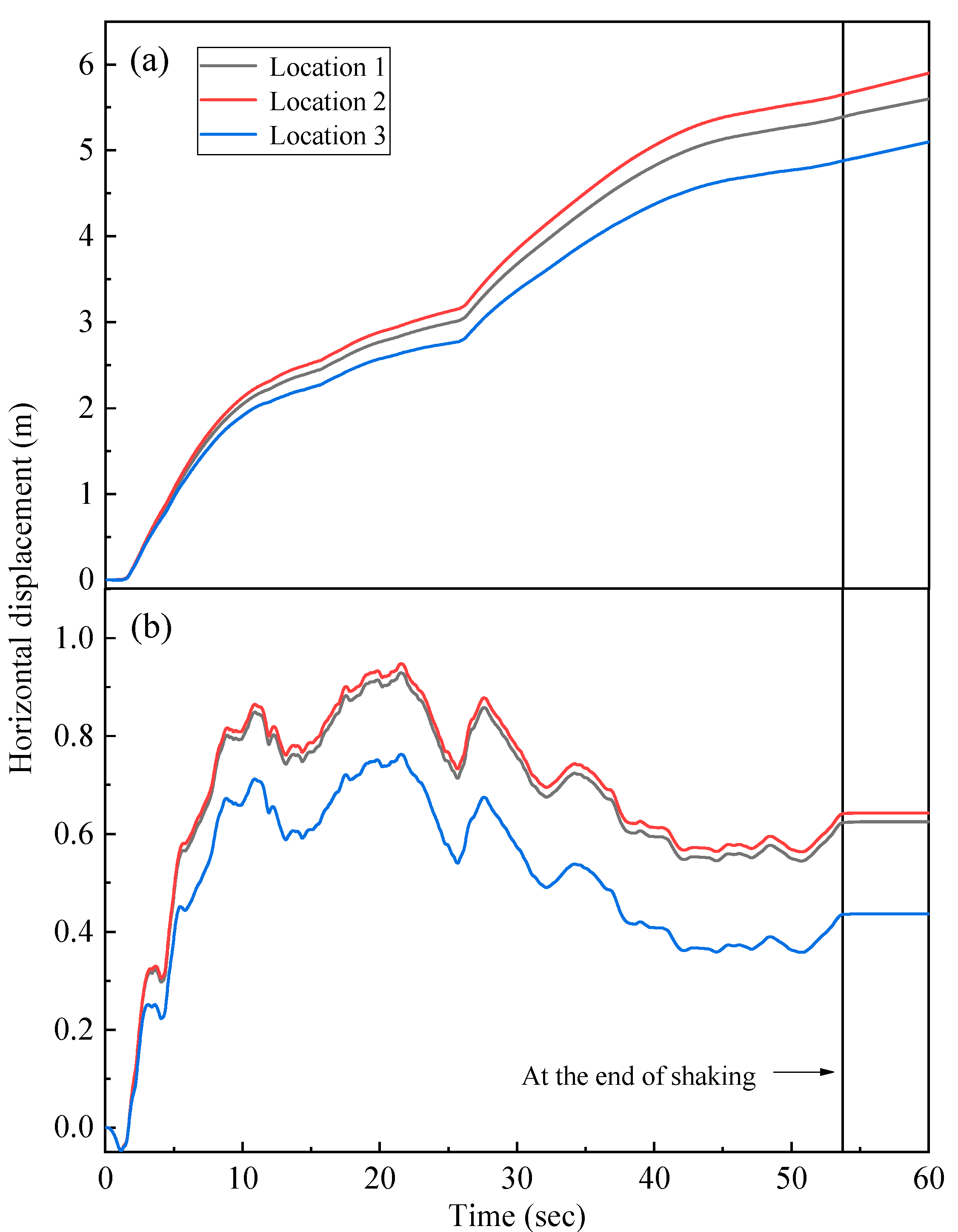
| Material | Density (kg/m3) | Elastic Modulus (MPa) | Poisson’s Ratio | Cohesion (kPa) | Friction Angle (o) |
|---|---|---|---|---|---|
| Gravel soil | 2000 | 40 | 0.15 | 22 | 30 |
| Mudstone (middle and front part of sliding zone) | 1888 | 3.7 | 0.3 | 20 | 17.6 |
| Mudstone (back part of sliding zone) | 1888 | 3.7 | 0.3 | 0 | 30 |
| Limestone (strong weathering) | 2397 | 1960 | 0.37 | 50 | 30 |
| Supporting Structure | Elastic Modulus (MPa) | Density (kg/m3) | Coupling Stiffness (MN/m2) | Coupling Cohesion (kN/m) | Coupling Friction Angle (o) | |||
|---|---|---|---|---|---|---|---|---|
| Normal | Shear | Normal | Shear | Normal | Shear | |||
| Anti-slide pile | 3 × 104 | 2500 | 2 × 105 | 2 × 105 | 10 | 30 | 0 | 30 |
| Supporting Structure | Elastic Modulus (MPa) | Density (kg/m3) | Bond Stiffness (MN/m2) | Cohesive Force (kN/m) | Friction Angle (o) | |
|---|---|---|---|---|---|---|
| Anchor cable | Free | 1.95 × 105 | 7850 | 0 | 0 | 0 |
| embedding | 2 × 104 | 150 | 25 | |||
Disclaimer/Publisher’s Note: The statements, opinions and data contained in all publications are solely those of the individual author(s) and contributor(s) and not of MDPI and/or the editor(s). MDPI and/or the editor(s) disclaim responsibility for any injury to people or property resulting from any ideas, methods, instructions or products referred to in the content. |
© 2023 by the authors. Licensee MDPI, Basel, Switzerland. This article is an open access article distributed under the terms and conditions of the Creative Commons Attribution (CC BY) license (https://creativecommons.org/licenses/by/4.0/).
Share and Cite
Zhou, L.; Su, L.; Wang, Z.; Zhu, D.; Shi, W.; Ling, X. Slope Stability and Effectiveness of Treatment Measures during Earthquake. Sustainability 2023, 15, 5309. https://doi.org/10.3390/su15065309
Zhou L, Su L, Wang Z, Zhu D, Shi W, Ling X. Slope Stability and Effectiveness of Treatment Measures during Earthquake. Sustainability. 2023; 15(6):5309. https://doi.org/10.3390/su15065309
Chicago/Turabian StyleZhou, Linlu, Lei Su, Zhuang Wang, Dongchun Zhu, Wei Shi, and Xianzhang Ling. 2023. "Slope Stability and Effectiveness of Treatment Measures during Earthquake" Sustainability 15, no. 6: 5309. https://doi.org/10.3390/su15065309





